
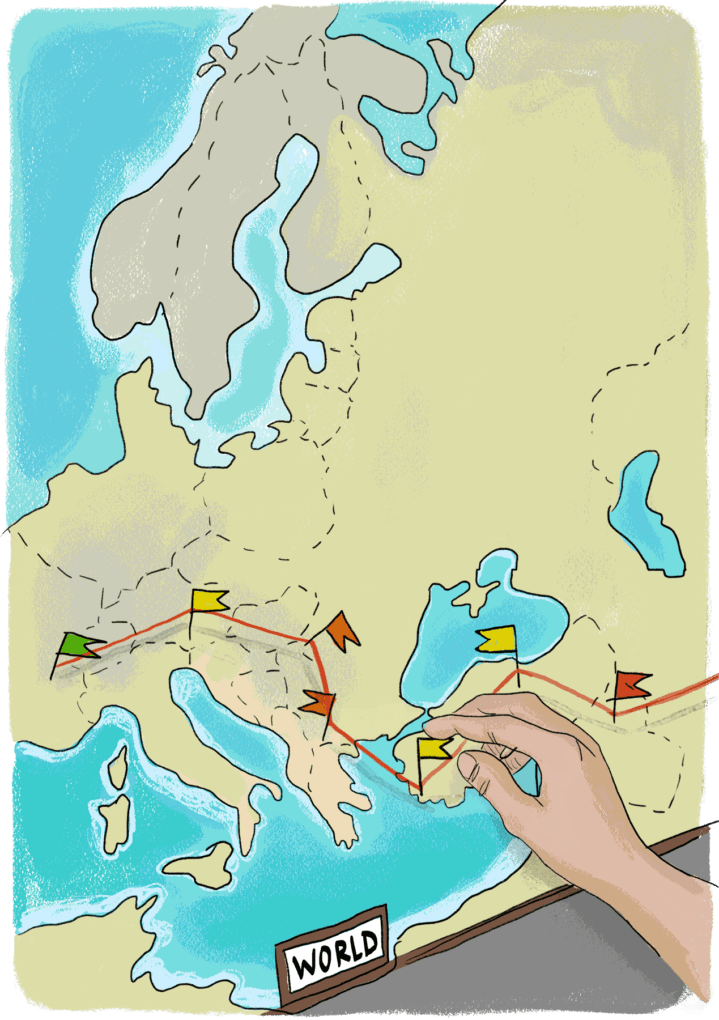
The most enjoyable part of preparing for a round-the-world trip is planning your itinerary. In this article we’ll explain, in detail, how to go about it and what mistakes you should avoid. We’ll also give you some examples of trips which you’ll be able to draw inspiration from.
In travelling forums and Facebook groups, you can read endless amounts of debates on the “real” definition of a round-the-world trip. In this article, we’ll stick to Macmillan’s dictionary: “Going round the world, and returning to the place that you started from.”
Doing a round-the-world trip doesn’t necessarily mean going to every country in the world, nor does it mean visiting every continent. For example, if you start in Europe and only go to Asia and America by crossing the Pacific and Atlantic Ocean, it’s still regarded as a round-the-world trip.
Between 17th and 20th May 2019, we carried out a huge study among 1435 people who’ve done a long trip. We asked them numerous questions about their itinerary. For the majority of the following statistics, we’ve only kept the responses relating to round-the-world trips (so about half), since that is the real topic of this article. The other responses will be used for future articles. Find out more about our methodology


The most visited destinations by european globetrotters are the furthest away from Europe: South America, Southeast Asia, New Zealand and Australia.
Indeed, when we go on this type of trip we often pick countries which are further away, and which we’ll have less likelihood of visiting on future holidays. What’s more, Europeans don’t need a visa for the majority of these countries.
Just over half of european globetrotters go to North America. Perhaps this is due to the fact that America and Canada are expensive, and they have a similar culture to Europe. Central American countries, on the other hand, undoubtedly suffer because of their dangerous reputation.
Africa is largely avoided. Contrary to popular belief, travelling in Africa is actually quite expensive. What’s more, passing through this continent increases the price of plane tickets, as it requires a large detour. In addition, the Foreign, Commonwealth & Development Office (FDCO) Travel Advice advise against all but essential travel to many countries in Africa, classifying them as orange or red zones.
Travellers don’t really go to the Middle-East or Central Asia because of their proximity to Europe. They’re also less visited because these areas are unknown and there’s not a lot of media coverage of them. Moreover, some of their countries are difficult to access or considered dangerous.
Finally, Europe isn’t usually visited during a round-the-world trip. European, globetrotters are looking for a taste of the exotic and feel that there’ll be more time to visit their own continent after their world tour.
We asked our globetrotters which countries they visited. We’re not necessarily advising you to go to the same countries as everyone else, but it’s always interesting to see what other travellers did.
The Pacific Islands are barely visible on the map. So, here are the percentages of globetrotters who went to each archipelago (unfortunately, we forgot Hawaii in our study).
We asked our globetrotters what their favourite countries were during their trip. For each country, we divided the amount of times each country was mentioned in the top three by the number of respondents who’ve visited this country. Therefore, we were able to identify frequent travellers’ favourite countries.
The number of respondents is low for some countries because very few travellers visit them. When there are less than 30 respondents, the margin for error is increased. However, by setting a threshold of 30 respondents, there would have only been very touristy areas in our ranking, and we thought that was a shame.
By our calculation method, a country that is visited by a lot of globetrotters is no more likely to be more highly rated than a country that is rarely visited. For that matter, among the ten favourite countries of respondents, only one – New Zealand – is part of the ten most visited countries.
It’s true, travellers tend to prefer less touristy countries where the locals are often warmer and more sincere. So, we advise you to draw inspiration from this ranking, and include less visited countries in your itinerary.
We asked our globetrotters about the main events they went to during their trip. If you want to go to a festival in a specific city or country, you can include it in your itinerary. This can be a great experience, but you may lose some flexibility, as you’ll have to be in a certain place at a certain time.
| Event | Date |
|---|---|
| Chinese New Year in China and all over Southeast Asia | End of January |
| Tapati Festival on Easter Island in Chile | Beginning of February |
| Flower Festival in Chiang Mai, Thailand | Beginning of February |
| Shivarati in Nepal | End of February |
| Rio Carnival in Brazil | End of February |
| Barranquilla’s Carnival in Colombia | End of February |
| Holi in India | Beginning of March |
| Nyepi (Balinese New Year) in Bali and Indonesia | End of March |
| Sakura (Cherry Blossom) in Japan | End of March – Beginning of April |
| Kanamara Matsuri (Festival of the Steel Phallus) in Kawasaki, Japan | Beginning of April |
| Holy Week (Semana Santa) in Latin America | Beginning of April |
| Songkran, Pi Mai or Buddhist New Year (Water Festival) in Thailand, Burma, Cambodia, Laos and Sri Lanka | Beginning of April |
| Khmer (Cambodian New Year) in Cambodia | Mid-April |
| Ramadan in Muslim countries | April in 2022 |
| Inti Raymi (Sun Festival) in Peru | End of June |
| Funeral Ceremonies in Sulawesi, Indonesia | from July to September |
| Mama Negra in Latacunga, Ecuador | End of September |
| Diwali (Festival of Lights) in India | End of October |
| Halloween in English-speaking countries | End of October |
| Dia de los muertos (Day of the Dead) in Latin America, particularly Mexico | Beginning of November |
| Loy Krathong (Festival of Lights) all over Southeast Asia | Mid-November |
| Full Moon Party in Kho Phangan, Thailand | Every month |
Globetrotters usually start their travels between August and January. There’s a peak in January after New Year’s celebrations, and another in September after summer holidays.
They generally come back in spring or summer. Coming back in these seasons helps to lighten any holiday blues that are linked to a change in climate – after spending months and months in glorious sunshine, it can be quite depressing to come back to a rainy country.
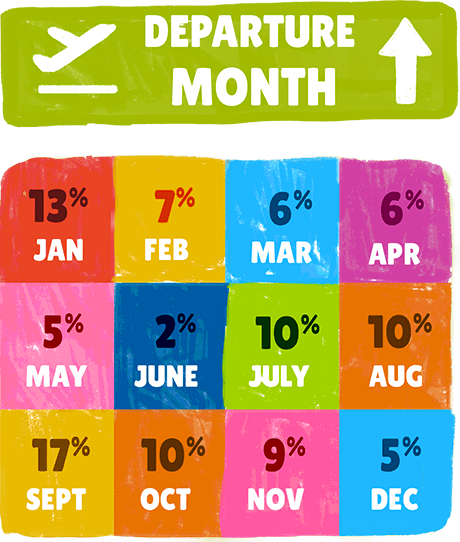



Among the respondents of our survey, there were almost as many travellers who took their trip from west to east as there were those who did it from east to west.
Which direction you decide to take depends on the departure date, as well as the seasons in the countries you go through. So, it’s mainly a question of weather.


When you’re planning your round-the-world trip itinerary, we advise you to take the following four steps:
Go and speak to your fellow traveller friends, read all of those travel blogs, forums and Facebook groups that you’ve been meaning to, and buy those travel guides and magazines you’ve always wanted. Perhaps then watch some relevant television programs, and listen to radio programs and podcasts. You can even look at UNESCO’s World Heritage Map. All of these inspiring resources will give you food for thought.
When making an initial list of all the countries, places, events, and experiences that you’d like to visit, attend and experience, make sure that it’s pretty extensive. At this stage of the planning, there are no limits. If there are several of you going on the trip, you can each make your own list. Once you think your list is finished, then start to rank it by prioritising what you really want to do at the top and what you’re willing to give up at the bottom.
If there are two (or more) of you, once everyone has completed their list you’ll need to compare your dream destinations. Places that come up on both of your lists are the easiest to choose. Then try to bridge the gap between each of your shared countries with countries that have only been chosen by one of you. It’s best to create an itinerary with as many bordering countries as possible. If you’re travelling with your family, you can involve your children in the decision-making by giving them the opportunity to choose a country.
This is possibly the most difficult step. Unless you’re willing to have a list as long as your arm and fancy dashing through each destination, you’re going to have to give up some countries. Start by getting rid of the countries which are far away from the majority of the places on your itinerary. In the rest of this article, we’ll review different criteria which will help you develop your itinerary further. This includes trip duration and pace, budget, transport, climate, safety and security, visas, borders and carbon footprint.
Money is usually the biggest constraint. In order to know which countries you can travel around and how much time you can spend there, you need to know what your budget is.
You can calculate the total amount of money that you have for a trip by analysing your savings, and by looking into any potential sources of funding that you can get your hands on (from family or sponsors, selling or renting your accommodation, travel grants, loans, pension…).
At the end of the day, your budget will heavily influence your choices. If it’s limited, you’ll need to visit cheaper countries, take less flights, opt for more economical means of transport and / or go on a shorter trip.
We’ve dedicated a whole article to budgeting your money. In it you can find globetrotters’ average expenses country by country. This will be very useful when you’re planning your itinerary.
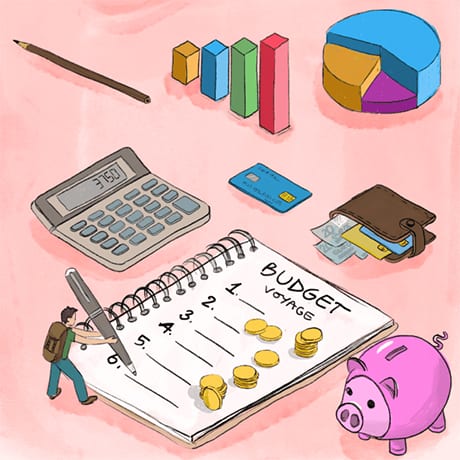

You can’t travel without a pretty penny!
The type of transport you take will also greatly influence your itinerary. You may choose a more classic round-the-world trip (getting on a plane for long distances and hopping on a bus / train for short distances), or you may opt for a round-the-world trip in a camper van, on bike, or even on a sailing boat. You need to bear in mind that these choices will alter the planning of your journey.
According to our study, 99% of globetrotters took a plane at least once during their trip. On average, they took 12 flights (flights with a layover are only counted as one flight). 67% of globetrotters took a round-the-world ticket and 33% bought their tickets one by one.
Some countries increase the price of round-the-world tickets. According to our study, the following destinations are avoided by globetrotters because of the price increase in plane tickets:
Globetrotters mainly travel on public transport (bus, train…) within continents.
However, around 20% of our surveys’ respondents mostly travelled with their own vehicle (car, van, camper van, motorbike, bike…). We can split them into three categories:
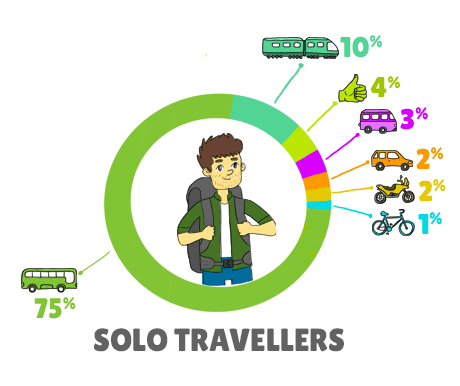

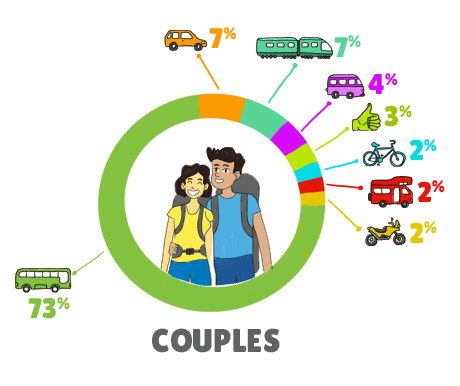



Less than 1% of respondents mentioned a boat as their key mode of transport. Perhaps this figure is under-estimated because, at the moment, we don’t really deal with this mode of transport on our website.
The mode of transport you choose is going to change the way you plan your trip:
Take a look at our articles on biking, vehicle shipping, boat hitch-hiking and transsiberian railway.
There are three main land routes to go from Europe to Asia:
You don’t have to have a fixed return date. If you’re heading off after a resignation, the end of your studies, a mutually agreed termination of contract, a firing, or if you work for yourself, nothing is forcing you to plan a return date; except your amount of savings. But we even advise you not to plan a return date. Doing this can lead to an incredible opportunity as it creates space for improvisation on your trip.
However, globetrotters who take sabbatical leave, unpaid leave, extended leave, parental leave or simply time off must have a fixed return date.
Generally speaking, a round-the-world ticket expires one year from the original date of purchase. By opting for this type of ticket, you’ll set a maximum duration on your trip, unless you’re willing to lose your last ticket.


Leaving without a fixed return date means absolute freedom.
According to our study, the average duration of a round-the-world trip is 11 months. Three-quarters of round-the-world trips last between 6 and 12 months.
If you’re travelling for less than nine months, we don’t recommend going around the world. It’s better to limit yourself to one, or perhaps two, continents. In this way, you’ll have more time to enjoy your trip and you’ll avoid pointlessly polluting the planet by taking an unnecessary amount of flights.
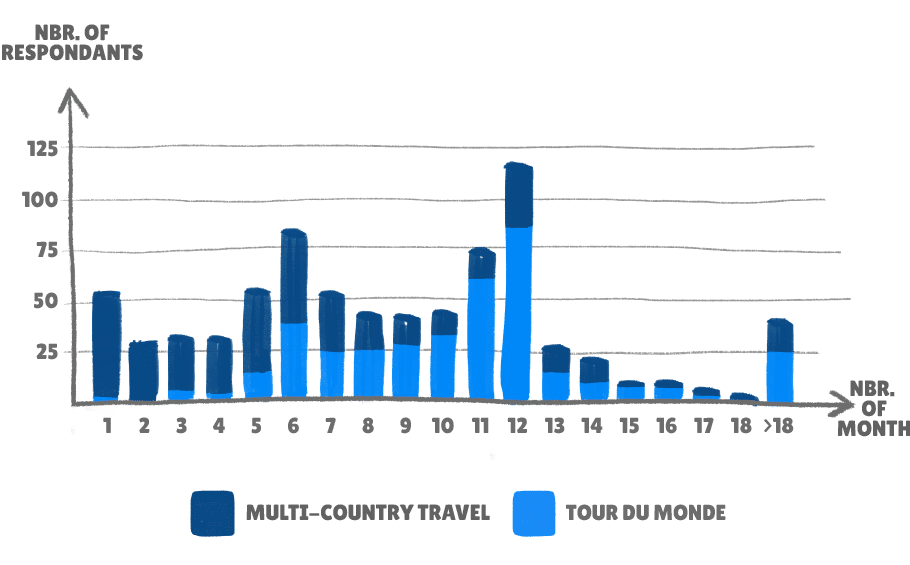

Both the duration and pace of your trip are going to determine the number of countries that you’ll be able to include in your itinerary.
When you start to think about your round-the-world trip, it’ll be difficult to stray away from your usual holiday planning habits. When we go on holiday for two or three weeks, most of us prefer to have a structured and specific idea for each step of the way. We often do this so that we don’t miss out on anything.
However, a long trip is very different. After a few months of travelling, you’ll get tired of constantly doing one sight-seeing tour after another. At the end of the day, don’t be too greedy. It’s better to visit less countries, but take more time to really explore the ones you do, by staying longer in each place.
The main attraction of a round-the-world trip is having the time to get off the beaten track. Don’t visit all the “must-see” sights and attractions recommended by guide books. They’re often expensive tourist hotspots. Instead, travel through more original and authentic places. They often have nice surprises in store, and you can meet more interesting people there. Never regret not being able to see everything, because in the end, the best moments are the simplest and most unexpected.
Our best example of this is from Indonesia. Travellers who go to this country generally follow more or less the same route through Java, Bali and Lombok. Mass tourism can be rife in these areas and it’s sometimes disappointing. François and I, on several solo trips, have spent a total of nine months in Indonesia. We visited these three islands, as well as all the other main islands which are much less touristy: Sumatra, Borneo, Sulawesi, Maluku, Papua New Guinea, Komodo, Flores and Timor. It’s one of our favourite countries and our greatest memories almost all took place outside of Java, Bali and Lombok!
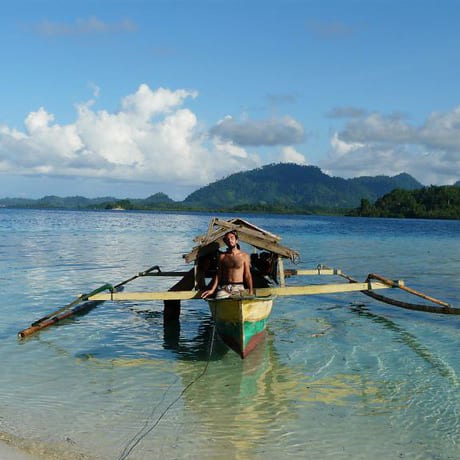

Francois in paradise lost in the Togian Islands, far far away from the Bali crowd!
The other huge advantage of a long trip, over a single holiday, is that you have time to create space for the unexpected. Therefore, we advise against planning an in-depth itinerary for each country. For some people, it’s very difficult to resist the temptation to do this. But, believe us, your trip will be so much more interesting if you don’t plan every little detail.
You can write a list of countries you’d like to visit, and the order in which you’d like to do it. But, be aware of the fact that most travellers veer away from their original itinerary. Being on the road is full of unexpected opportunities, so be prepared to grab hold of them. These might include places where you want to stay a little longer, or perhaps where there are people you want to hang out with for a bit. Whatever it is, don’t hesitate to change your plans as it’s often a great experience.
Your trip around the world might be the only point in your life when you’ll have time to devote several weeks, or even months, to an activity abroad. For example, you can take the opportunity to work, volunteer, do some wwoofing, complete a diving certification, do a long trek or take some language classes.
During our round-the-world trip, we did the Annapurna trek by foot in three weeks, whilst also taking the time to do some side treks. I also stayed in Gili Trawangan, Indonesia, for two months so that I could do my Divemaster. Finally, I stayed in Buenos Aires for a month (and François in Mendoza) to learn Spanish before starting the Latin American part of our trip. These three experiences are some of the best memories of our whole trip.


Sylvain doing his Divemaster. Diving for two months non-stop!
Being on the road for several months and moving around all the time will wear you out. If you spend your time doing one tourist attraction after another, and change location every three days for a year, that could be the end of you. Some globetrotters even end up having a kind of travel burnout.
It might sound strange, but it’s a good idea to plan some downtime during your trip. If you tell your close friends and family, they might laugh at you: “What, you need a holiday to rest from your holiday?”. However, we really recommend that you allow yourself some time to rest during your trip.
According to our study, globetrotters visited an average of 13 countries, and stayed in each one for an average of 25 days. However, in hindsight, many of them feel that their pace was too fast. A lot of them told us that if they were to do it again, they would travel through fewer countries and spend more time in each destination.
That was also the case for us. During our trip around the world, we realised that we’d been too greedy. We wanted to visit too many countries. We lingered in some places where we felt good (such as Nepal and Indonesia), we decided to spend a month learning Spanish in Argentina, and we added Colombia along the way, as many other travellers recommended this country. However, as we had a fixed return date, we had to make up for lost time. This meant travelling through some countries without stopping (New Zealand, Panama and Costa Rica) and others very quickly (Chile, Ecuador and Nicaragua). This also meant that we didn’t have time to go to Patagonia.
You should therefore allow at least one month per country on average, or even a little more if you go through big countries and / or travel with your vehicle. A round-the-world trip isn’t a race to get as many stamps in your passport as possible. Before you go, make the effort to “sacrifice” some countries, however frustrating it may be.
To help you estimate how much time to spend in each country on your itinerary, we’ve calculated the average time spent in each country by travellers who responded to our survey.
As long as your visa allows it, we suggest that you factor in at least 20% more time than stated in the table below. This will help you take into account the amount of respondents who would’ve liked to travel more slowly.
| Country | Average Duration of Stay |
|---|---|
| Albania | 10 days |
| Antarctica | 12 days |
| Argentina | 30 days |
| Armenia | 6 days |
| Australia | 30 days |
| Austria | 3 days |
| Azerbaijan | 8 days |
| Belgium | 5 days |
| Belize | 8 days |
| Bolivia | 21 days |
| Bosnia-Herzegovina | 4 days |
| Botswana | 13 days |
| Brazil | 19 days |
| Brunei | 4 days |
| Bulgaria | 5 days |
| Cambodia | 21 days |
| Canada | 30 days |
| Chile | 30 days |
| China | 30 days |
| Colombia | 30 days |
| Cook Islands | 11 days |
| Costa Rica | 15 days |
| Croatia | 10 days |
| Cuba | 18 days |
| Czech Republic | 3 days |
| Denmark | 5 days |
| Dominican Republic | 18 days |
| Easter Island | 5 days |
| Egypt | 15 days |
| Ecuador | 20 days |
| Estonia | 8 days |
| Ethiopia | 40 days |
| Fiji | 13 days |
| Finland | 7 days |
| France | 22 days |
| French Polynesia | 19 days |
| Gabon | 25 days |
| Galapagos Islands | 9 days |
| Georgia | 14 days |
| Germany | 5 days |
| Country | Average Duration of Stay |
|---|---|
| Greece | 17 days |
| Guadeloupe | 31 days |
| Guatemala | 15 days |
| Honduras | 10 days |
| Hong Kong | 4 days |
| Hungary | 4 days |
| Iceland | 15 days |
| India | 30 days |
| Indonesia | 30 days |
| Iran | 29 days |
| Ireland | 7 days |
| Israel | 10 days |
| Italy | 11 days |
| Ivory Coast | 17 days |
| Jamaica | 17 days |
| Japan | 21 days |
| Jordan | 9 days |
| Kazakhstan | 14 days |
| Kenya | 18 days |
| Kyrgyzstan | 30 days |
| Laos | 21 days |
| Latvia | 6 days |
| Lithuania | 5 days |
| Madagascar | 30 days |
| Malaysia | 16 days |
| Maldives | 7 days |
| Mauritius | 7 days |
| Mexico | 30 days |
| Mongolia | 25 days |
| Montenegro | 6 days |
| Morocco | 18 days |
| North Macedonia | 5 days |
| Myanmar | 23 days |
| Namibia | 21 days |
| Nepal | 30 days |
| Nicaragua | 21 days |
| Netherlands | 6 days |
| New Caledonia | 21 days |
| New Zealand | 35 days |
| Norway | 15 days |
| Country | Average Duration of Stay |
|---|---|
| Oman | 7 days |
| Uzbekistan | 20 days |
| Pakistan | 30 days |
| Panama | 15 days |
| Paraguay | 8 days |
| Peru | 28 days |
| Philippines | 29 days |
| Poland | 7 days |
| Portugal | 13 days |
| Reunion Island | 17 days |
| Romania | 8 days |
| Russia | 23 days |
| Salvador | 12 days |
| Scotland | 13 days |
| Serbia | 7 days |
| Singapore | 4 days |
| Slovakia | 2 days |
| Slovenia | 5 days |
| South Africa | 28 days |
| South Korea | 15 days |
| Spain | 10 days |
| Sri Lanka | 28 days |
| Sweden | 10 days |
| Switzerland | 4 days |
| Tajikistan | 21 days |
| Taiwan | 21 days |
| Tanzania | 21 days |
| Thailand | 30 days |
| Turkmenistan | 5 days |
| Turkey | 20 days |
| Ukraine | 14 days |
| United Arab States | 5 days |
| United Kingdom | 7 days |
| United States | 30 days |
| Uruguay | 7 days |
| Vanuatu | 20 days |
| Vietnam | 25 days |
| Zambia | 8 days |
| Zimbabwe | 4 days |
Staging your itinerary will be largely influenced by the climate. The best seasons differ for each country. Even within the same country, the climate can strongly vary from one region to another. There are many websites (such as Travelpicker, Where & When to Travel, and Climates to Travel) which specify the best and worst months for each destination. Or you can search “climate + name of city” on Google, to instantly find out about the temperature and the number of sunny days for each month of the year in a specific place.
However, organising the stages of your trip by the weather may leave you tearing your hair out. At the time of our round-the-world trip, we had to make an Excel spreadsheet with the destinations in rows, and the months in columns. We then coloured the boxes in green or red to highlight whether the climate was good or not. Finally, we moved the lines around until we found a coherent itinerary with as many pleasant climates as possible.
Since then, Nicolas has developed a great online tool, A-contresens travel planner, which does just that. It allows you to build your itinerary whilst showing you the climate in every country at the precise time you plan to travel through it. While this is entirely in French, there’s really nothing else like it at the moment. So, we wholly recommend using it, and clicking ‘translate the page into English’. It should work just fine!
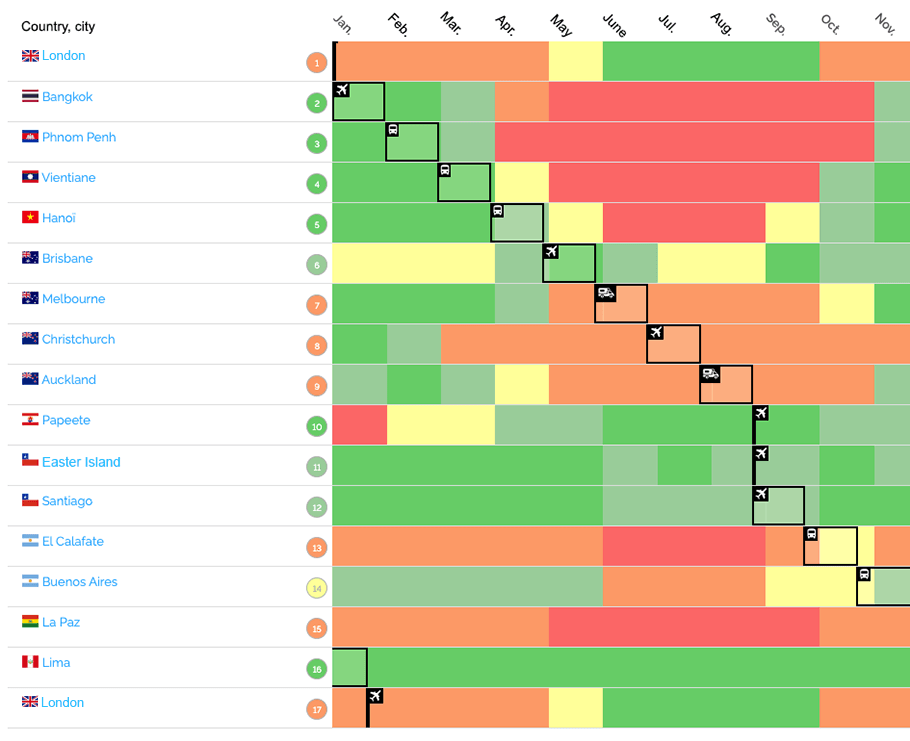

We advise you to input only one city per country (or two or three maximum if the climate varies a lot). You can then change the order of your route to avoid visiting countries when it’s cold or rainy. Don’t expect to travel in the best season every step of the way.
If you always travel when the climate is at its best, you may end up rubbing shoulders with a lot of tourists. So, don’t underestimate the difference between travelling in high season and in low season. Can you imagine the difference between the French Riviera in spring and August? Well, on the roads of Nepal, or at the temples of Angkor, it’s exactly the same thing, except that the peak seasons vary for each destination.
A good way to combine a pleasant climate and a bearable tourist population is to travel during shoulder seasons. To help you find the right time to travel, The Culture Trip maps each country’s high and low seasons for each month of the year.
Before committing to a country in your itinerary, we advise you to look at the FCDO Travel Advice. Here you can find regularly updated travel advice and information by country, for British citizens. The FCDO advise whether it’s safe, or not, to visit a country. The advice for each country will be stated as: ‘Against all travel’, ‘All but essential travel’, or ‘No travel restrictions’. For higher risk countries, you’ll also find a colour coded map that highlights whether it’s safe, or not, to travel.
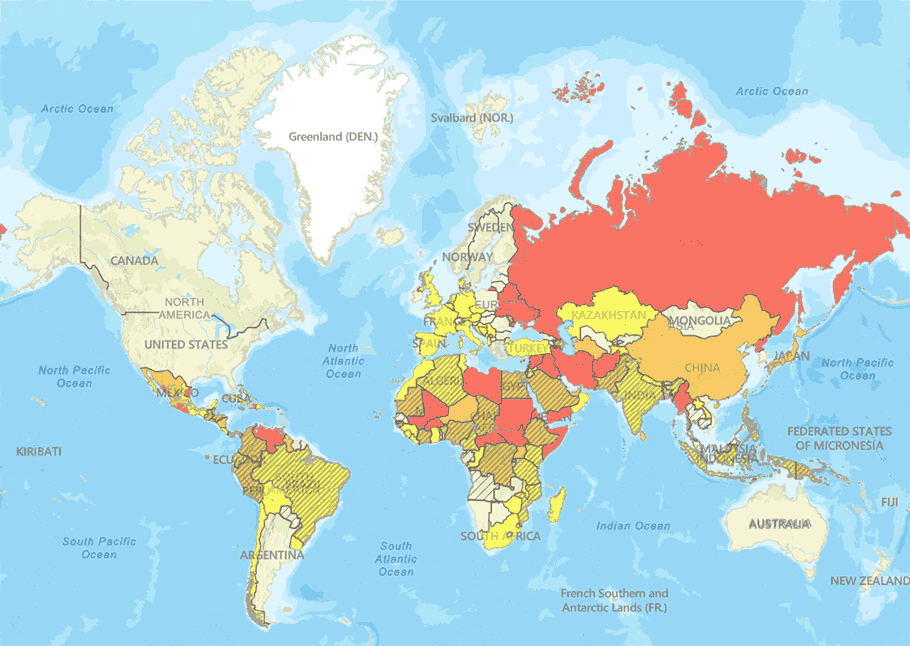

You’ll then need to decide how far you’re prepared to go based on the potential risks:
Reading the Foreign travel advice can be quite worrying. Indeed, even for countries that seem safe, the website often highlights threatening risks. However, you should bear in mind that its aim is to identify, as comprehensively as possible, all the possible dangers linked to each country. Therefore, you must take it with a pinch of salt.
Similar services are available for other English-speaking countries:
In Latin America and Europe, British citizens can freely travel without a visa. However, in Asia, Oceania, North America and Africa, many countries require you to have a visa or another type of permit.
If you want to go to countries that require a visa, you’ll need to at least plan your entry so that you have time to sort out your applications in advance.
Most visas can be obtained in the country’s consulate anywhere in the world, but sometimes the process is long and / or complicated. For example, travellers who take the Trans-Siberian Railway often start their journey in Russia to avoid having to do their visas (Russian, Mongolian and Chinese) along the way.
Nowadays, more and more countries offer e-visas or an electronic travel authorisation (eTA). You can apply for these documents online, without having to go to a consulate. This certainly makes life easier, and saves time, when you’re on the road. However, whilst they may work well for entering by air, they don’t always allow you to cross land borders.
Whether a visa is necessary or not, the length of your stay in a country as a tourist will always be limited, and it’s often between 30 and 90 days.
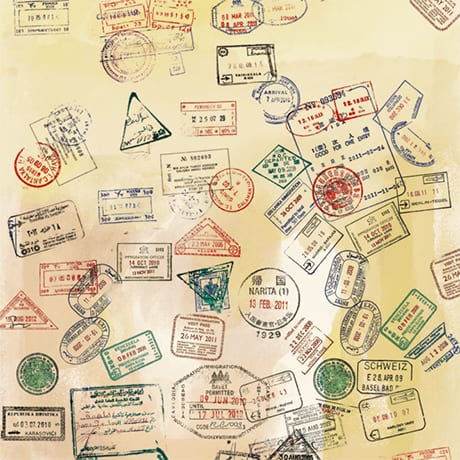

British citizens can visit 136 countries without a visa.
To help you understand how this affects your itinerary, we’ve written an article on visas. In it you can find out what type of permit you need, as well as the maximum amount of time you can stay in each country.
Make sure that the land borders you plan to cross on your route are open. We say this because some borders are shut for safety reasons, or because the two countries involved have bad relations. Other borders may be open, but they are often located in dangerous areas and are limited to travellers with a certain type of visa.
Lots of globetrotters look for information about the following borders:
If you want to look at all the border crossings in Central Asia, take a look at the following link: Border crossings on the Silk Road
During a long trip, flying is by far the biggest contributor to global warming. It makes up around three quarters of globetrotters’ CO2 emissions.
If you want to reduce your carbon footprint whilst travelling, you should really aim to take less flights. You may be a zero-waste traveller, but if you take several flights your eco-friendly attempts will unfortunately be of little use.
The best way to minimise your environmental impact is by finding alternatives to air travel.
In order to achieve this, you need to nurture this state of mind right from the planning stages of your trip. The goal is to try to shape your itinerary so that you move by land (ideally by public transport, biking, or hitch-hicking) or sea (preferably by sailing boat) as much as possible.
Take a look at our article on How to Reduce Your Environmental Impact While Traveling


Having an itinerary with a limited number of flights helps you minimise your carbon footprint.
We’ve created a highly detailed downloadable spreadsheet so that you can evaluate your estimated budget, and even follow your spending habits during your trip. In particular, it lets you estimate your total budget depending on the amount of time you plan on spending in each country.
Yes, unfortunately it’s in French, but a simple right click will translate the entire website for you. Trust us on this one, it’s worth it, as this is the only planning tool that has been specifically designed for long-term travellers. It lets you build your itinerary online and shows you whether the climate is pleasant in a specific destination at a specific time. Then you can see this data on a map. This tool will ask you to choose one city per destination, which subsequently makes you don’t overplan your trip. As we said earlier, we don’t encourage you to plan every step in detail for each country.
If you’re a whizz with spreadsheets, you might enjoy making your own budget and climate spreadsheets, instead of using our tool or A-contresens.
If you don’t want to use A-contresens, you could simply use Google Maps in order to visualise your itinerary.
Polarsteps is an app which automatically tracks and records your itinerary during your trip. It does this by using your mobile phone’s GPS.
You can share your journey with your close ones as they follow you on a digital map, and it has a timeline on the side which lets you add thoughts, messages and photos.
You can choose to activate GPS tracking through the mobile phone app. It can be set to a low-power mode to help your mobile phone battery last longer. And, if you leave your GPS tracking enabled, Polarsteps suggests locations based on places you’ve previously visited. It also automatically geotags your photos.
You can add locations and continue to be GPS tracked whilst offline. Then, when you have a network connection, your data will be automatically synced.
If you fancy, you can print out a Travel Book at the end of your trip. The Travel Book is automatically generated and it compiles your map itinerary, photos and messages.
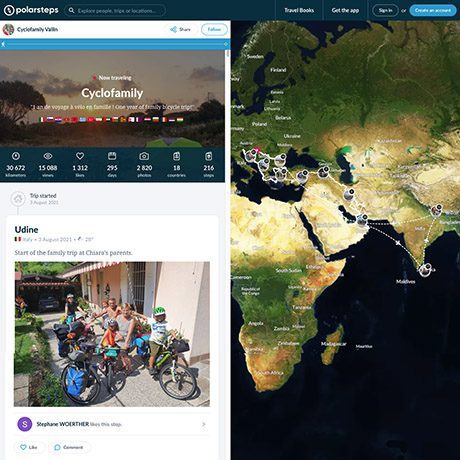

Record your trip on a map thanks to your mobile phone’s GPS.
To summarise this article, here are our main bits of advice to help you create your itinerary. It all comes from our experience, as well as our study and analysis of 525 globetrotters’ response to this following question: “What advice would you give to someone who’s in the process of planning the itinerary for their trip?”.
Here are some samples of round-the-world itineraries. We’re not telling you to pick one and stick to it step by step. Instead, we want you to use them as sources of inspiration. There are as many itineraries as there are globetrotters, and almost all of them change along the way. For each itinerary, we show the duration, main modes of transport, number of flights, amount of CO2 emitted by these flights and budget. We’ve deliberately only put one or two cities per country; as we said before, we advise against planning a whole in-depth itinerary for each country.
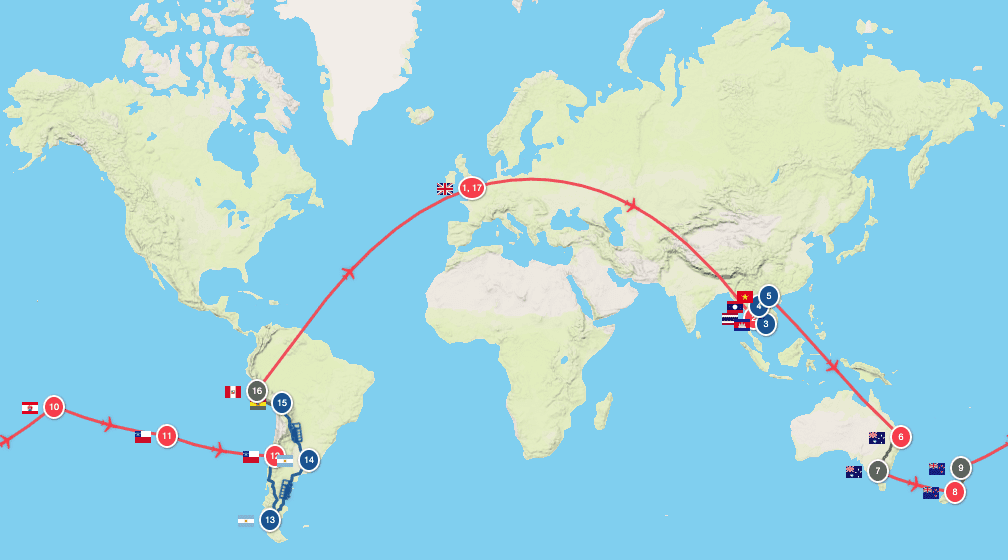

| Thailand | 4 weeks |
|---|---|
| Laos | 4 weeks |
| Vietnam | 4 weeks |
| Cambodia | 4 weeks |
| Australia | 7 weeks |
| New-Zealand | 6 weeks |
| Tahiti | 2 weeks |
|---|---|
| Easter Island | 1 week |
| Chile | 4 weeks |
| Argentina | 7 weeks |
| Bolivia | 4 weeks |
| Peru | 5 weeks |
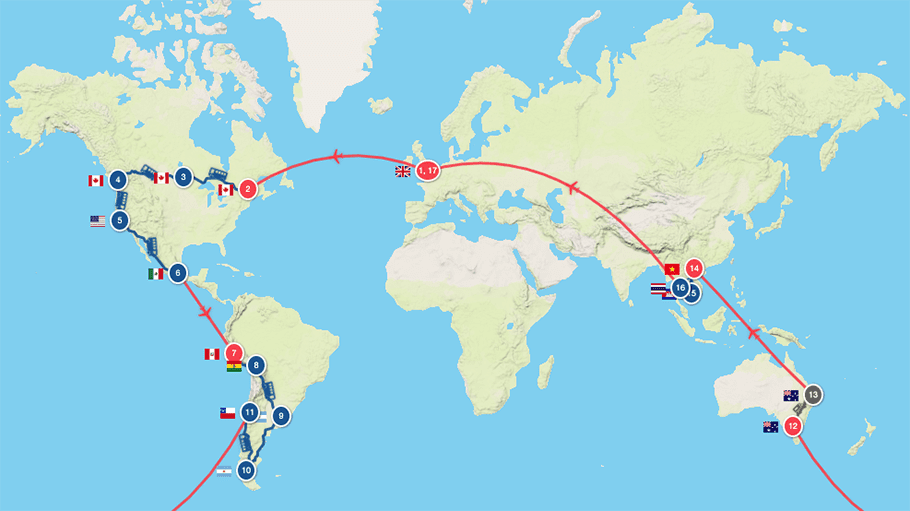

| Canada | 5 weeks |
|---|---|
| United States | 6 weeks |
| Mexico | 5 weeks |
| Peru | 5 weeks |
| Bolivia | 4 weeks |
| Argentina | 5 weeks |
| Chile | 4 weeks |
|---|---|
| Australia | 6 weeks |
| Vietnam | 4 weeks |
| Cambodia | 4 weeks |
| Thailand | 4 weeks |


| Denmark | 1 week |
|---|---|
| Russia | 4 week |
| Mongolia | 4 week |
| China | 4 week |
| Japan | 4 week |
| Vietnam | 4 week |
| Cambodia | 4 week |
| Thailand | 4 week |
| Myanmar | 4 week |
|---|---|
| Malaisia | 3 week |
| Australia | 5 week |
| Hawaii | 2 week |
| United States | 4 week |
| Cuba | 4 week |
| Ireland | 1 week |


| Myanmar | 4 weeks |
|---|---|
| Thailand | 4 weeks |
| Laos | 4 weeks |
| Cambodia | 4 weeks |
| Vietnam | 4 weeks |
| Indonesia | 6 weeks |
| Cuba | 4 weeks |
|---|---|
| Mexico | 5 weeks |
| Peru | 4 weeks |
| Bolivia | 4 weeks |
| Chile | 4 weeks |
| Argentina | 5 weeks |


| South Africa | 5 weeks |
|---|---|
| Namibia | 4 weeks |
| Botswana | 2 weeks |
| Zimbabwe | 2 weeks |
| Mozambique | 4 weeks |
| Tanzania | 4 weeks |
| Thailand | 4 weeks |
| Cambodia | 4 weeks |
|---|---|
| Vietnam | 4 weeks |
| New Zealand | 6 weeks |
| Chile | 4 weeks |
| Bolivia | 4 weeks |
| Peru | 5 weeks |
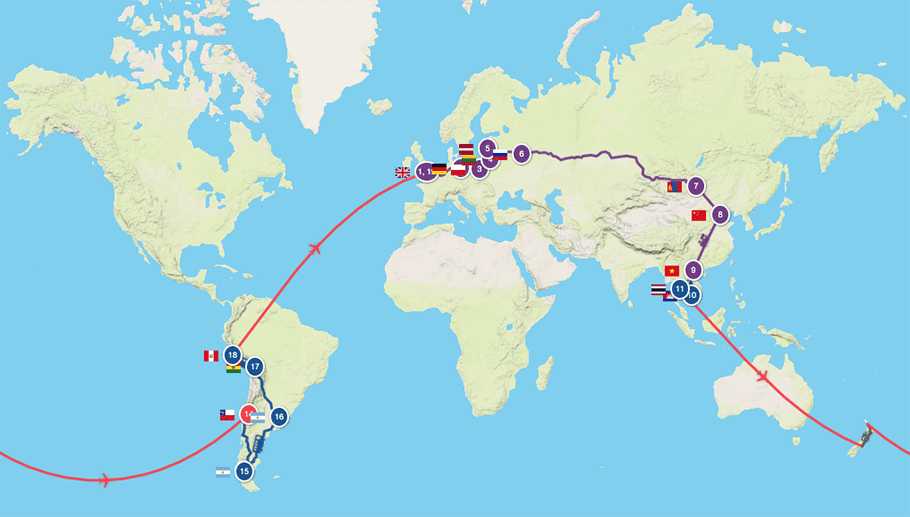

| Germany | 1 week |
|---|---|
| Poland | 1 week |
| Lithuania | 1 week |
| Latvia | 1 week |
| Russia | 4 weeks |
| Mongolia | 4 weeks |
| China | 4 weeks |
| Vietnam | 4 weeks |
| Cambodia | 4 weeks |
|---|---|
| Thailand | 4 weeks |
| New Zealand | 5 weeks |
| Chile | 4 weeks |
| Argentina | 6 weeks |
| Bolivia | 4 weeks |
| Peru | 5 weeks |


| Philippines | 4 weeks |
|---|---|
| Thailand | 4 weeks |
| Laos | 4 weeks |
| Cambodia | 4 weeks |
| Vietnam | 4 weeks |
| China | 4 weeks |
| South Korea | 3 weeks |
| Hawaii | 1 week |
|---|---|
| Peru | 5 weeks |
| Bolivia | 4 weeks |
| Chile | 4 weeks |
| Argentina | 5 weeks |
| Brazil | 6 weeks |
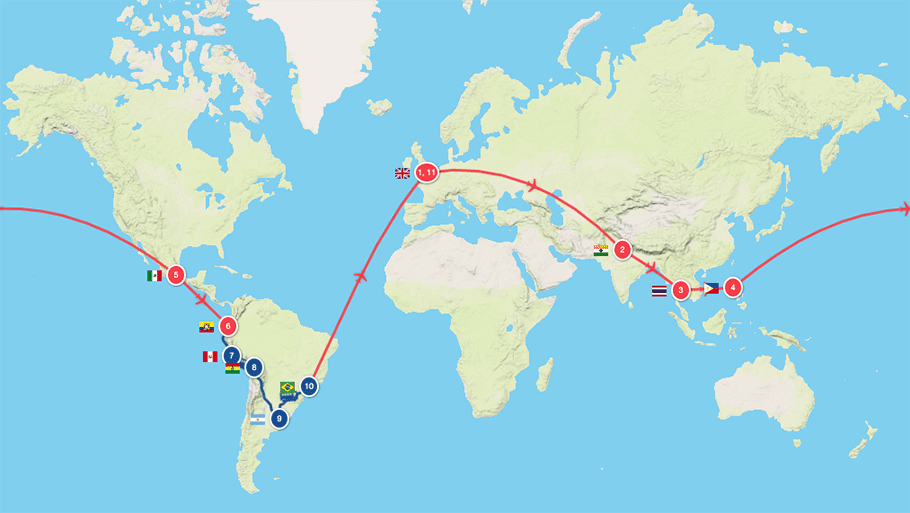

| India | 14 weeks |
|---|---|
| Thailand | 8 weeks |
| Philippines | 4 weeks |
| Mexico | 4 weeks |
| Ecuador | 12 weeks |
| Peru | 32 weeks |
|---|---|
| Argentina | 2 weeks |
| Uruguay | 2 weeks |
| Brazil | 6 weeks |
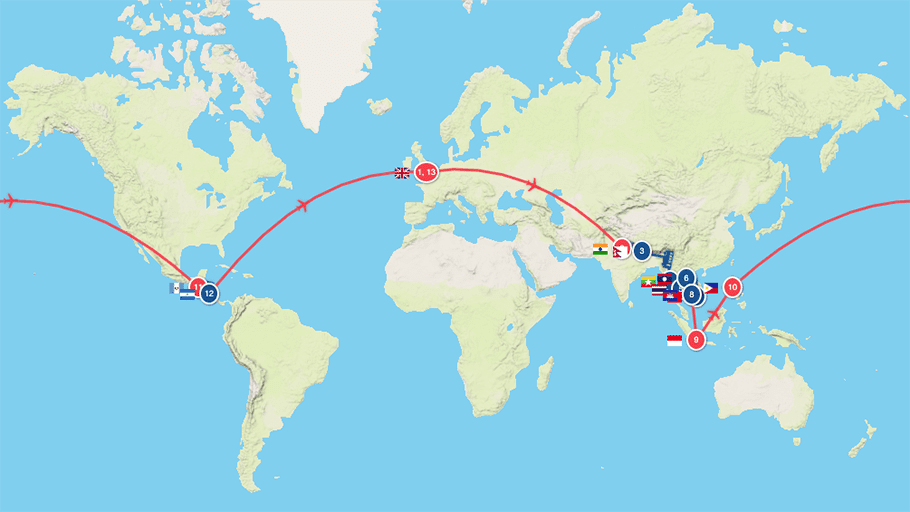

| India | 6 weeks |
|---|---|
| Nepal | 4 weeks |
| Myanmar | 4 weeks |
| Thailand | 4 weeks |
| Laos | 4 weeks |
| Vietnam | 4 weeks |
| Cambodia | 4 weeks |
| Indonesia | 7 weeks |
|---|---|
| Philippines | 5 weeks |
| Guatemala | 3 weeks |
| El Salvador | 2 weeks |
| Honduras | 2 weeks |
| Nicaragua | 3 weeks |
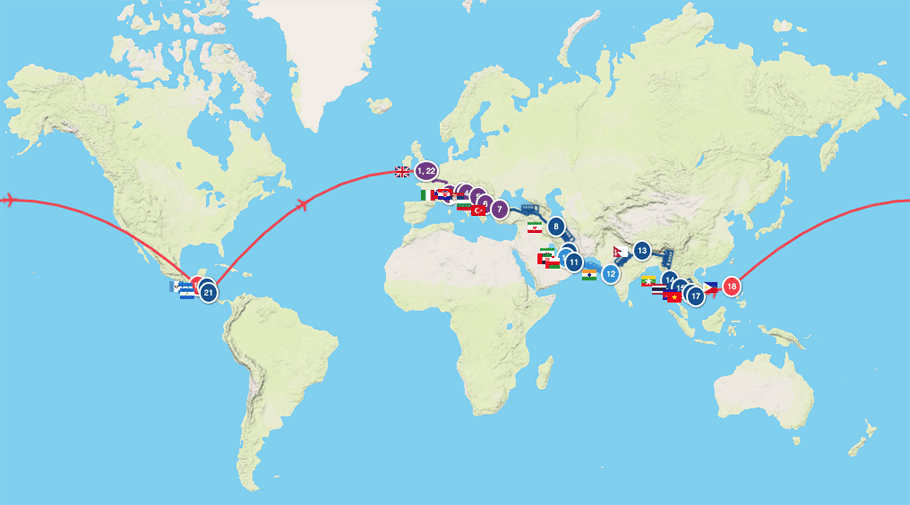

| Italy | 1 week |
|---|---|
| Slovenia | 1 week |
| Croatia | 2 weeks |
| Serbia | 1 week |
| Bulgaria | 1 week |
| Turkey | 4 weeks |
| Iran | 4 weeks |
| United Arab Emirates | 1 week |
| Oman | 1 week |
| India | 5 weeks |
| Nepal | 4 weeks |
|---|---|
| Myanmar | 4 weeks |
| Thailand | 4 weeks |
| Cambodia | 4 weeks |
| Vietnam | 4 weeks |
| Philippines | 4 weeks |
| Guatemala | 3 weeks |
| Honduras | 2 weeks |
| Nicaragua | 2 weeks |


| Spain | 3 weeks |
|---|---|
| Ecuador | 5 weeks |
| Peru | 10 weeks |
| Bolivia | 5 weeks |
| Argentina | 9 weeks |
| Chile | 8 weeks |
| United States | 8 weeks |
| Canada | 8 weeks |
| Alaska | 5 weeks |
| South Korea | 3 weeks |
| Japan | 4 weeks |
| Vietnam | 2 weeks |
| Cambodia | 3 weeks |
| Thailand | 4 weeks |
| Myanmar | 2 weeks |
| Laos | 3 weeks |
| China | 8 weeks |
|---|---|
| Kyrgyzstan | 6 weeks |
| Tajikistan | 3 weeks |
| Uzbekistan | 2 weeks |
| Kazakhstan | 1 week |
| Azerbaijan | 1 week |
| Georgia | 1 week |
| Turkey | 8 weeks |
| Greece | 1 week |
| North Macedonia | 1 week |
| Serbia | 1 week |
| Montenegro | 1 week |
| Croatia | 1 week |
| Slovenia | 1 week |
| Austria | 1 week |
| Germany | 1 week |


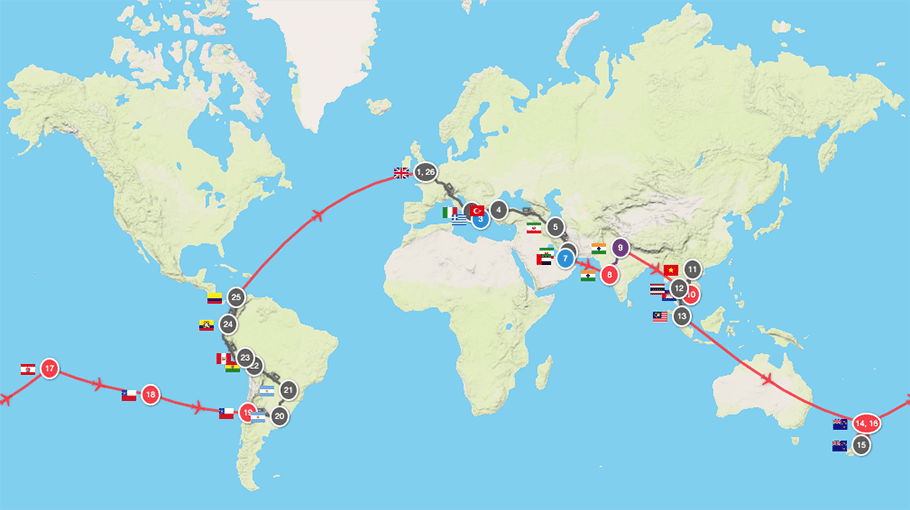

| Italy | 2 weeks |
|---|---|
| Greece | 2 weeks |
| Turkey | 3 weeks |
| Iran | 4 weeks |
| Dubai | 1 week |
| India | 3 weeks |
| Cambodia | 3 weeks |
| Vietnam | 3 weeks |
| Thailand | 4 weeks |
| Malaisia | 2 weeks |
| New Zealand | 4 weeks |
|---|---|
| Polynesia | 1 week |
| Easter Island | 1 week |
| Chile | 4 weeks |
| Argentina | 3 weeks |
| Bolivia | 3 weeks |
| Peru | 4 weeks |
| Ecuador | 2 weeks |
| Colombia | 3 weeks |
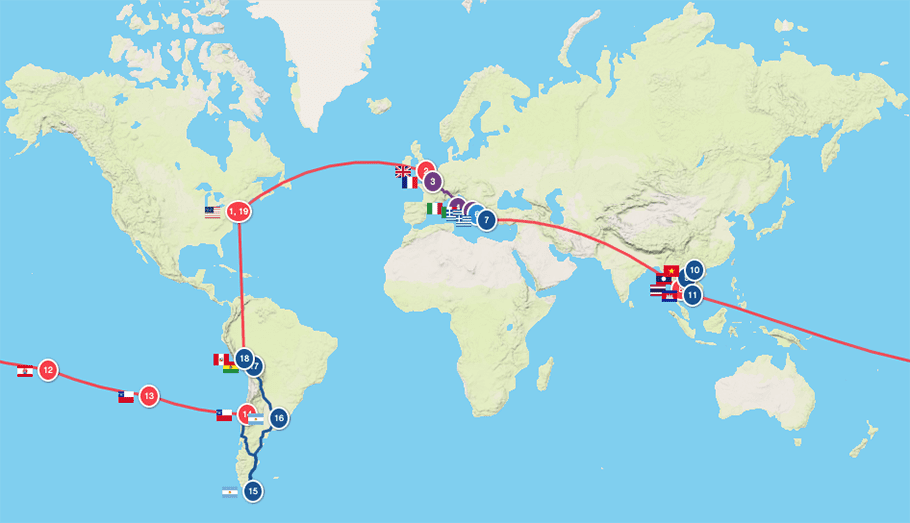

| France | 2 weeks |
|---|---|
| Italy | 2 weeks |
| Greece | 2 weeks |
| Thailand | 4 weeks |
| Laos | 4 weeks |
| Vietnam | 4 weeks |
| Cambodia | 4 weeks |
| French Polynesia | 2 weeks |
|---|---|
| Easter Island | 1 week |
| Chile | 4 weeks |
| Argentina | 6 weeks |
| Bolivia | 4 weeks |
| Peru | 5 weeks |
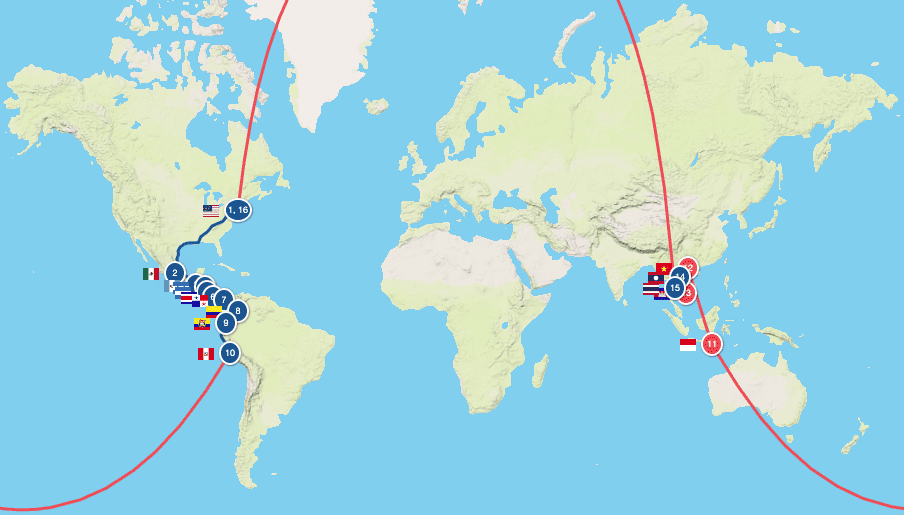

| United States | 4 weeks |
|---|---|
| Mexico | 5 weeks |
| Guatemala | 2 weeks |
| Honduras | 2 weeks |
| Nicaragua | 2 weeks |
| Costa Rica | 2 weeks |
| Panama | 2 weeks |
| Colombia | 5 weeks |
| Ecuador | 3 weeks |
|---|---|
| Peru | 4 weeks |
| Indonesia | 5 weeks |
| Vietnam | 4 weeks |
| Cambodia | 4 weeks |
| Laos | 4 weeks |
| Thailand | 4 weeks |
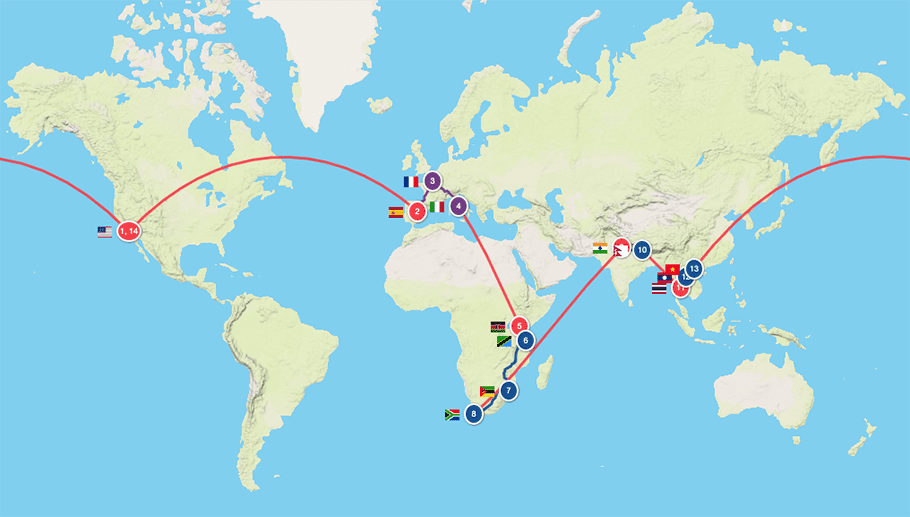

| Spain | 3 weeks |
|---|---|
| France | 3 weeks |
| Italy | 3 weeks |
| Kenya | 3 weeks |
| Tanzania | 4 weeks |
| Mozambique | 4 weeks |
| South Africa | 5 weeks |
|---|---|
| India | 6 weeks |
| Nepal | 5 weeks |
| Thailand | 5 weeks |
| Laos | 4 weeks |
| Vietnam | 5 weeks |


| United Kingdom | 1 week |
|---|---|
| France | 1 week |
| Italy | 1 week |
| Slovenia | 1 week |
| Croatia | 2 weeks |
| Serbia | 1 week |
| Bulgaria | 1 week |
| Turkey | 4 weeks |
| Georgia | 1 week |
|---|---|
| Azerbaijan | 1 week |
| Turkmenistan | 1 week |
| Uzbekistan | 3 weeks |
| Kyrgyzstan | 4 week |
| China | 6 weeks |
| South Korea | 3 weeks |
| Japan | 4 weeks |
| Guatemala | 3 weeks |
| Mexico | 5 weeks |
| United States | 5 weeks |
We did our round-the-world trip between 2008 and 2009. We’ll be the first ones to tell you that it’s not a very good example.
Like lots of globetrotters, we realised en route that we’d been too greedy.
We wanted to visit too many countries. We stayed longer in some countries where we felt good (like Nepal and Indonesia), we decided to spend a month learning Spanish in Argentina, and we added Colombia to the itinerary during the trip, as many other travellers recommended visiting this country.
So, to make up for lost time, we had to go through some countries without stopping (New Zealand, Panama and Costa Rica) and through others very quickly (Chile, Ecuador and Nicaragua). This also meant that we didn’t have time to go to Patagonia.
We also took too many flights, because, in those days, we weren’t as aware of the environmental impact that flights have on global warming.
It’s interesting to show you our itinerary so that you can avoid making the same mistakes!
| India | 4 weeks |
|---|---|
| Nepal | 3 semaines |
| Thailand | 4 weeks |
| Singapore | 1 weeks |
| Indonesia | 4 weeks |
| Timor Leste | Not planned |
| Australia | 4 weeks |
| New Zealand | 4 weeks |
| Chile | 2 weeks |
| Argentina | 4 weeks |
| Bolivia | 3 weeks |
| Peru | 4 weeks |
| Ecuador | 2 weeks |
| Colombia | Not planned |
| Panama | 1 week |
| Costa Rica | 2 weeks |
| Nicaragua | 2 weeks |
| Honduras | 2 weeks |
| Guatemala | 2 weeks |
| Mexico | 4 weeks |
| Inde | 3 weeks |
|---|---|
| Népal | 6 weeks |
| Thaïlande | 4 weeks |
| Singapour | 1 week |
| Indonésie | 7 weeks |
| Timor Oriental | 1 week |
| Australie | 4 weeks |
| New Zealand |
Skipped
|
| Chile | 1 week |
| Argentina | 6 weeks |
| Bolivia | 2 weeks |
| Peru | 3 weeks |
| Ecuador | 1 week |
| Colombia | 4 weeks |
| Panama |
Skipped
|
| Costa Rica |
Skipped
|
| Nicaragua | 1 week |
| Honduras | 3 weeks |
| Guatemala | 2 weeks |
| Mexico | 3 weeks |

